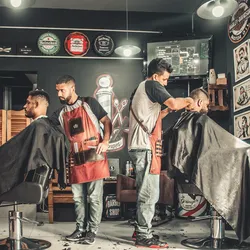
Level 1
A hairstyle is how someone’s hair looks. Some hairstyles are good for work. A bob is one kind of hairstyle that’s good for work. It’s not too long or too short. A ponytail is another good hairstyle for work. It keeps hair out of someone’s face. A crew cut is a good haircut for work. It’s very short and easy to take care of. A lob is a popular haircut now. It’s a bit longer than a bob. People like it because it looks pretty and is easy to take care of.
Level 2
A hairstyle is how a person’s hair looks. Certain hairstyles are suitable for work. A bob is a kind of hairstyle that works well for work because it’s not too long or too short. Another good hairstyle choice for work is a ponytail as it keeps hair out of the face. A crew cut is also a practical haircut for work since it is short and effortless to manage. Currently, a lob is a trendy haircut choice because it is slightly longer than a bob and requires minimal maintenance while looking pretty.
Full Story
with hairstyles, there are several options that are considered professional. One of the most popular ones is a classic bob, which is shoulder-length and can be styled straight or with gentle waves for a chic and sophisticated look. Another option is a sleek ponytail, which is perfect for those with longer hair. This hairstyle keeps hair out of your face and looks polished, making it a go-to choice for many professionals.
If you are looking for a haircut that grows out well, there are a few options to consider. The first is a layered cut, which allows for more flexibility as your hair grows out. This style provides volume and movement, which makes it a great choice for those who want to keep their hair looking fresh between haircuts. Another option is a shaggy cut, which also works well as it grows out. This style features lots of layers and texture, which means that even as your hair grows, it will still look stylish.
with the most business haircut, it really depends on the industry and company culture. However, a short, neat haircut such as a crew cut or a slicked-back undercut is often considered a safe bet. These styles are clean-cut and low-maintenance, while still looking professional.
The most popular haircut currently is the lob, which is a long bob. This style sits just above the shoulders and can be worn straight or wavy. It’s versatile, easy to style, and has been seen on many celebrities and influencers. Another popular option is the pixie cut, which is a short, cropped style that is edgy and bold.
A business haircut typically refers to a short, neat style that is easy to maintain and doesn’t require much styling. This type of haircut is popular among professionals because it looks clean-cut and put-together.
Cutting hair can absolutely be a side hustle. Many people choose to cut hair as a way to make extra money on the side, either by opening up their own salon or by offering their services freelance.
Finally, a financial haircut refers to a type of debt restructuring that involves reducing the amount owed to creditors. This term is often used in the finance industry to describe a process where a borrower negotiates with their lenders to reduce their debt burden.
There are many different types of hairstyles and haircuts that are considered professional, stylish, and easy to maintain. Whether you’re looking for something that grows out well, is low-maintenance, or is popular at the moment, there is sure to be an option that suits your needs. And if you’re interested in cutting hair as a side hustle, know that it’s definitely possible to turn your passion into a profitable venture.
Questions
What is a bob hairstyle and why is it considered appropriate for work?
How does a ponytail hairstyle help in the workplace?
Which type of haircut is considered to be easy to take care of?
In your opinion, which hairstyle mentioned in the article do you think is the most stylish?
Do you agree that certain hairstyles are more suitable for work? Why or why not?
Fill in the Blanks
undercut, neat, haircut, lob, edgy, popular, hairstyle, professional, business
with hairstyles, there are several options that are considered ________.
One of the most ________ ones is a classic bob, which is shoulder-length and can be styled straight or with gentle waves for a chic and sophisticated look.
This ________ keeps hair out of your face and looks polished, making it a go-to choice for many professionals.
If you are looking for a ________ that grows out well, there are a few options to consider.
with the most ________ haircut, it really depends on the industry and company culture.
However, a short, ________ haircut such as a crew cut or a slicked-back ________ is often considered a safe bet.
The most popular haircut currently is the ________, which is a long bob.
Another popular option is the pixie cut, which is a short, cropped style that is ________ and bold.
Vocabulary
Hairstyle: a particular way in which a person’s hair is cut and arranged
Professional: appropriate to the workplace or a professional setting; having the skill, training, or qualities necessary for a particular job or activity
Haircut: the act of cutting a person’s hair, typically with scissors or clippers
Grow out: to become longer as new hair grows in place of old hair
Business: related to commerce, trade, or the pursuit of profit
Popular: liked or admired by many people; commonly encountered or widely accepted
Neat: clean, orderly, and tidy
Crew cut: a very short haircut, usually for men, in which the hair is clipped close to the scalp
Undercut: a hairstyle in which the sides and/or back of the head are shaved or closely cropped while the top is left longer
Lob: a long bob haircut that falls just above the shoulders
Pixie cut: a short, cropped hairstyle popularized by actress Mia Farrow in the 1960s
Edgy: daring, bold, or unconventional in style or character
Side hustle: a secondary job or income stream that supplements one’s main source of income
Debt restructuring: a process in which a debtor renegotiates the terms of their debt with their creditors in order to reduce their debt burden
Finance industry: the businesses and organizations involved in managing money, including banks, investment firms, and insurance companies.




